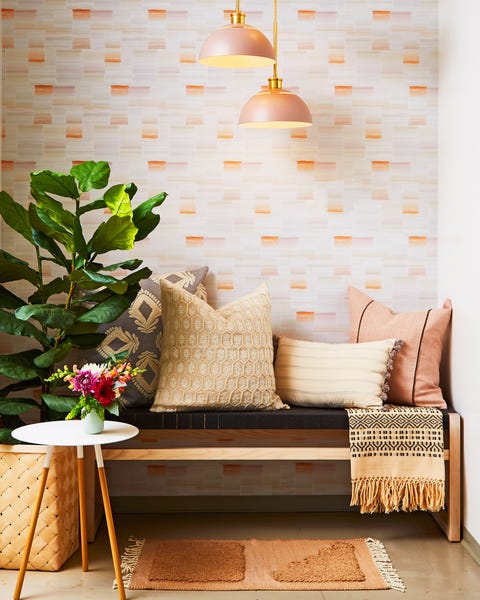After a stifling summer, settling into a cozy fall at home sounds idyllic — and there’s no better time to infuse your space with inviting, warm colors than when the weather cools down.
“Fall is the perfect time to embrace warm colors in your home, as the natural autumn color palette ranges the whole warm side of the color wheel,” says Decorist designer Erika Dale. “Refreshing your textiles, art, accessories, or floral arrangements with these autumnal hues can embrace the coziness and warmth of the season.”
So what does it actually mean and look like to decorate your home with warm colors? Three interior designers offer their tips for translating the color wheel into perfectly balanced colorful decor.
What are examples of warm colors?
“In general, warm colors are those in the red, orange, and yellow families, while cool colors are those in the green, blue, and purple families,” Dale says. Think scarlet, peach, pink, amber, sienna, and gold versus cooler teal, eggplant, emerald, aqua, and cobalt. Remember the color wheel from grade school art class? A line drawn right through the middle divvies up those two groupings, although hues near where the halves meet (like purple) can function as “hybrid colors,” Dale says.
You can also think of warm colors as cozy, earthy tones. “For me, warm colors are camel leathers, oranges, deep grays, and taupes,” says Decorist designer Baylee Deyon. “Cooler colors are usually lighter and bring an airy feel to a room.”
Is white a cold or warm color?
Both! White can lean cooler or warmer, depending on the shade. “If you look closely, you can see hints of the undertones like red, blue, yellow, and purple in the color,” says Ariel Richardson, interior designer and founder of ASR Design Studio in San Diego.
It may take some practice to pick up on these subtle tints, but they can make a big impact on how a paint color or piece of furniture will look in a room. “Yellow or pink undertones will read warmer, while whites with blue or green undertones will appear cooler,” Dale explains.
Different types of lighting can also influence whether a white will look more warm or cool — hence why many designers recommend testing a big swatch on the wall before painting an entire room. “If you have tons of natural light pouring in, things will appear cooler, whereas rooms lit with artificial light will look much warmer,” Dale says.
Don’t worry about matching every white in a room perfectly. Utilizing both cool and warm whites can bring in the best of both worlds. “I love layering a crisp, clean white with other warmer whites because it makes for a light and airy, yet cozy and warm vibe,” Deyon says.
Okay, so is gray a cold or warm color?
Just like white, gray can also function as a warm or cool color. If you want one that skews warm for your walls, try Classic Gray by Benjamin Moore. “It feels light and airy, but there is also a warm elegance and formality to it that makes it perfect for a living room with bright white trim,” Dale says.
How can you tell if a color is warm or cool?
“You can tell if a color is warm if it seems to be more mellow,” Richardson says. “Bold and vivid colors tend to be on the cold side.”
If you’re still questioning your eyes, try this easy trick from Dale: Hold the swatch or item in question next to a pure version of that color (e.g., put your white against a true white from the color wheel). You’ll quickly determine which way it leans when you see them side-by-side.
How do warm colors make you feel?
“Warm colors instantly conjure up associations with heat, fire, and the sun, so these colors tend to feel more energetic, inviting, cozy, stimulating, passionate, and intimate,” Dale says. “Conversely, cool colors bring to mind water and the sky and therefore a create a more calming, focused, relaxed, restful, soothing, and refreshing feeling.”
Besides influencing your mood, color temperatures can change the feel of a room, too. Warmer colors can make an interior seem welcoming – but also smaller, Richardson warns. Cooler colors have their own pros and cons: They’ll create the illusion of extra space, but go overboard and the room can feel too sterile.
Should warm and cold colors be put in the same room?
Yes! “One of the best design tricks in the book is creating a nice balance of warm and cool colors in a space,” Dale says. “While the dominant colors in a room can dictate the overall mood, what makes the design feel grounded and cohesive is balancing that out with elements of the opposite color temperature.” For example, if you are going for that light and airy look with cool white walls, adding in warm elements such as a red rug, ivory linens, or brass accents can help make the room still feel cozy and inviting.
How do you decorate with warm colors?
Richardson advises using cooler colors on the walls and ceilings to make a room appear more spacious, but layering in warm touches through the architectural details, furniture, lighting, finishes, fixtures, and accessories.
But what about bringing in those fall colors like mustard, terra cotta, ochre, or persimmon? Switching up the accessories can quickly update your home for the season. “Incorporating warm-colored throw blankets and pillows to a space can make a huge impact,” Deyon says. “I love to swap out my greenery with something such as natural dried cotton stems to make for a textured and cozy space.”







